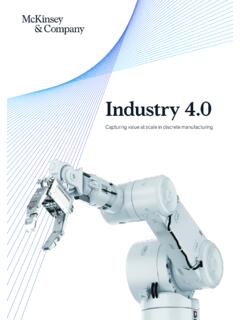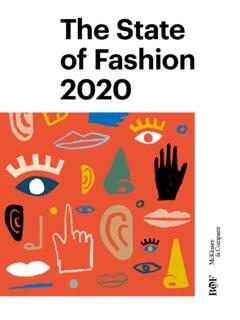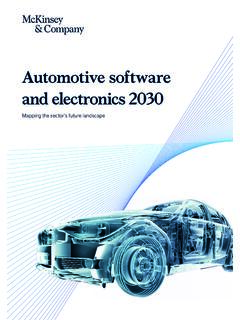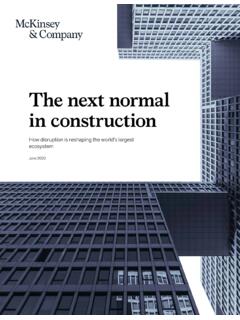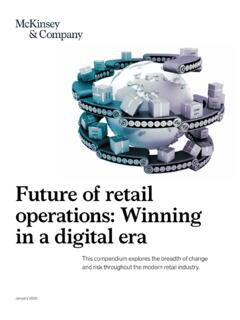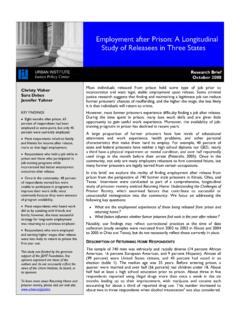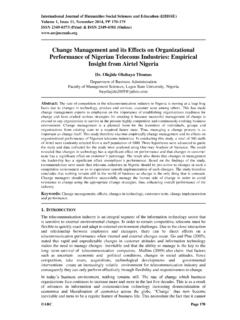Transcription of Automotive revolution – perspective towards 2030
1 Advanced Industries January 2016 Automotive revolution perspective towards 2030 How the convergence of disruptive technology-driven trends could transform the auto industry3 Automotive revolution perspective towards 2030 IntroductionToday s economies are dramatically changing, triggered by development in emerging markets, the accelerated rise of new technologies, sustainability policies, and changing consumer preferences around ownership. Digitization and new business models have revo-lutionized other industries, and Automotive will be no exception. For the Automotive sector, these forces are giving rise to four disruptive technology-driven trends: diverse mobility, autonomous driving, electrification, and connectivity. Most industry players and experts agree that these four technology-driven trends will re inforce and accelerate one another, and there is general consensus that the industry is ripe for disruption. Yet although the widespread sentiment that game-changing disruption is already on the horizon, there is still no integrated perspective on how the Automotive industry will look in 10 to 15 years as a result of these trends.
2 With this publication we aim to make the imminent changes more tangible. We start from the general consensus that the industry is transforming and go further to specify and quan-tify the magnitude of change. The forecasts in this study should, thus, be interpreted as a projection of the more probable assumptions across all four trends, based on our current understanding. The forecast methodology is certainly not deterministic in nature (Text box 1), but should help industry players better prepare for the uncertainty by discussing potential future scenarios (Text box 2).There are many tough, fundamental, or even existential questions that are looming for automakers and suppliers. Some commentators suggest these disruptions will mark the decline of the Automotive industry. But in our view, growth in the personal mobility market will accelerate as new sources of recurring revenues supplement slowing growth from one-time vehicle sales. Text box 1: The methodology behind Automotive revolution perspective towards 2030 Research on the future of mobility conducted in collaboration with Stanford University Substantial industry-wide research covering perspectives from incumbents, new entrants, start-ups, academia, as well as investment and legal firms Extensive executive interviews and in-depth discussions with over 30 industry experts in Asia, Europe, and the United States A proprietary quantitative market model integrating macroeconomic development, future mobility behavior, electric vehicle and autonomous vehicle diffusion4 Automotive revolution perspective towards 2030 Text box 2: Overview of the high-disruption vs.
3 The low-disruption scenarioHighLowDiverse mobilityCity policies discouraging private vehiclesIntensifiedSteadyNew, on-demand business modelsPrevalentLimitedModal shift away from car ownership to shared mobilitySignificantLimitedAutonomous drivingRegulatory challenges are overcomeFastGradualDevelopment of safe and reliable technical solutionsComprehensiveIncompleteConsumer acceptance and willingness to payEnthusiasticLimitedElectrificationBat tery prices continue to declineRapidProtractedRegulator-driven emission restrictionsIntensifiedGradualConsumer demand for electrified powertrainsWidespreadRestrainedConnectiv ityUptake of car connectivity globallyVast majorityPartialConsumers regularly using paid contentMainstreamLimited We drafted eight key perspectives on the 2030 Automotive revolution to provide insights into the kind of changes that are coming and how they will affect traditional OEMs and suppliers, potential new players, regulators, consumers, national car markets, and the Automotive value chain.
4 Shifting markets and revenue pools1. Driven by shared mobility, connectivity services, and feature upgrades, new business models could expand Automotive revenue pools by ~30 percent, adding up to ~USD Despite a shift towards shared mobility, vehicle unit sales will continue to grow, but likely at a lower rate of ~2 percent in mobility behavior3. Consumer mobility behavior is changing, leading to up to one out of ten cars sold in 2030 potentially being a shared vehicle and the subsequent rise of a market for fit-for-purpose mobility City type will replace country or region as the most relevant segmentation dimension that determines mobility behavior and, thus, the speed and scope of the Automotive revolution perspective towards 2030 Diffusion of advanced technology5. Once technological and regulatory issues have been resolved, up to 15 percent of new cars sold in 2030 could be fully autonomous. 6. Electrified vehicles are becoming viable and competitive; however, the speed of their adoption will vary strongly at the local level.
5 New competition and cooperation7. Within a more complex and diversified mobility industry landscape, incumbent players will be forced to simultaneously compete on multiple fronts and cooperate with New market entrants are expected to initially target only specific, economically attractive segments and activities along the value chain before potentially exploring further on our analysis of these eight perspectives, which are explained in more detail in the following four chapters, we believe incumbent players need to make fundamental and strate-gically vetted decisions now to shape the industry s future by preparing for uncertainty, lever-aging partnerships, adapting the organization, and reshaping the value markets and revenue poolsSome commentators argue that the Automotive industry is in decline; however, we contend that growth is actually accelerating, stemming from new revenue streams, including shared mobility and data connectivity services as well as continuing global macroeconomic growth in emerging Driven by shared mobility, connectivity services, and feature upgrades, new business models could expand Automotive revenue pools by ~30 percent, adding up to ~USD trillionThe Automotive revenue pool will significantly increase and diversify towards on-demand mobility services and data-driven services.
6 This could create up to ~USD trillion (or 30 percent more) in additional revenue potential in 2030, compared to ~USD trillion from traditional car sales and aftermarket products/services (up from ~USD trillion in 2015). Together, these revenues could accelerate annual Automotive industry growth to percent (up from about percent from 2010 to 2015).Connectivity, and later autonomous technology, will increasingly allow the car to become a platform for drivers and passengers to use their transit time for personal activities, which could include the use of novel forms of media and services. The increasing speed of innova-tion, especially in software-based systems, will require cars to be upgradable. As shared mobility solutions ( , car sharing or e-hailing) with shorter lifecycles will become more common, consumers will be constantly aware of technological advances, which will further increase demand for upgradability in privately used cars as revolution perspective towards 2030 SOURCE.
7 McKinseyThe Automotive revenue pool will grow and diversify with new services potentially becoming a ~USD trillion market in 2030 To d a yTraditional Automotive revenuesVehicle sales +30%306, ,500 USD billionsNew Automotive revenues, 2030 Recurring revenues significantly increasing1 Does not include traditional taxi and rentalsAftermarket Growth with increased vehicle sales Higher annual maintenance spend for shared vehicles 20-30% lower maintenance spend on electric powertrains Up to 90% lower average crash repair per autonomous vehicleOne-time vehicle sales ~2% annual global increase in vehicle unit sales driven by macroeconomic growth in emerging economies Price premiums paid for electric powertrains and autonomous driving technology featuresRecurring revenues Shared mobility penetrates dense and suburban cities with new car sharing and e-hailing business models1 >USD 100 billion from data connectivity services, incl. apps, navi-gation, entertainment, remote services, and software upgradesHIGH-DISRUPTION SCENARIOE xhibit 17 Automotive revolution perspective towards 20302.
8 Despite a shift towards shared mobility, vehicle unit sales will continue to grow, but likely at a lower rate of ~2 percent global car sales will continue to grow, but the annual growth rate is expected to drop from the percent of the last five years to ~2 percent annually by 2030. This drop will be largely driven by macroeconomic factors and the rise of new mobility services such as car sharing and detailed analysis suggests that dense areas with a large, established vehicle base are fertile ground for these new mobility services, and many cities and suburbs of Europe and North America fit this profile. New mobility services may result in a decline of private vehicle sales, but this decline is likely to be partially offset by increased sales in shared vehicles that need to be replaced more often due to higher utilization and related wear and remaining driver of growth in global car sales is the overall positive macroeconomic development, including the rise of the global consumer middle class.
9 As established mar-kets are no longer expanding, growth will continue to rely on emerging economies, particu-larly China and and future annual vehicle sales, millions Driven by urbanization and macroeconomics, global vehicle sales will continue to grow, although at a slower paceSOURCE: IHSA utomotive; McKinsey41231058710 Private vehicles2015 Urbanization and macro-economic growth2030 Fewer privatevehicles115 New shared vehiclesHIGH-DISRUPTION SCENARIOE xhibit 28 Automotive revolution perspective towards 2030 Changes in mobility behaviorWhen considering the potential for industry transformation, consumer prefer-ences and behavior are an important starting point. We believe the disruptive technology-driven trends have the potential to fundamentally change the rela-tionship between the consumer and the Consumer mobility behavior is changing, leading to up to one out of ten cars sold in 2030 potentially being a shared vehicle and the subsequent rise of a market for fit-for-purpose mobility solutionsConsumer preferences, tightening regulation, and technological breakthroughs add up to a fundamental shift in individual mobility behavior.
10 Individuals increasingly use multiple modes of transportation to complete their journey, and goods and services are increasingly deliv-ered to (rather than fetched by) consumers. As a result, the traditional business model of car sales will be complemented by a range of diverse on-demand mobility solutions, especially in dense urban environments that proactively discourage private car today use their cars as all-purpose vehicles, no matter if commuting alone to work or taking the whole family to the beach. In the future, they may want the flexibility to choose the best solution for a specific purpose, on demand and via their smartphones. We can already observe significant, early signs that the importance of private car ownership is declining and shared mobility is increasing. In the US, for example, the share of young peo-ple (16 to 24 years) that hold a driver s license dropped from 76 percent in 2000 to 71 per-cent in 20131, while the number of car sharing members in North America and Germany has grown by more than 30 percent annually over the last five ,3 The shift to shared mobility, enabling consumers to use the optimal solution for each purpose, will lead to new segments of specialized vehicles designed for very specific needs.
